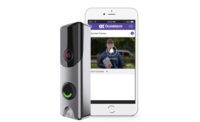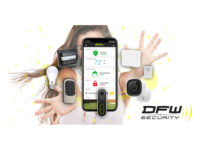The security industry hasn’t been the same since smartphone apps came along. Many homeowners now expect smartphone control of their security systems. Increasingly they are also expecting to be able to interact via smartphone with door locks, thermostats, lights and video cameras.
So what comes next? We talked to security equipment manufacturers and dealers about what’s new in this area, what’s under development and what capabilities are expected to hit the market in the near future.
Here are five key trends we identified.
1. CURATED Z-WAVE DEVICES
End users love smartphone control. But they don’t like it when they have to pull up different apps to control different devices in the home.
Many security systems now support Z-Wave, a popular communications technology for a wide range of devices such as lighting, door locks and thermostats — and using Z-Wave can help address this concern. But even though many security systems interwork with Z-Wave devices, dealers should be wary of using just any Z-Wave device with their systems, cautions Mike Hackett, senior vice president of sales and marketing for San Jose, Calif.-based manufacturer Qolsys Inc.
Z-Wave is an open standard, which means some basic functionality should always work, Hackett explains. He notes, though, that while a smartphone app for a particular security panel might be able to turn a Z-Wave thermostat on and off, it might not give the end user the ability to set schedules for that thermostat in an intuitive manner.
To address this, some security manufacturers or other providers of smartphone security apps increasingly are finding themselves curating Z-Wave devices — working with manufacturers of devices as diverse as garage door openers and water valve controls to help ensure that those devices have a high level of interoperability with the app and the security system that the app controls.
2. E-COMMERCE CAPABILITY
Some smartphone apps also are introducing e-commerce capability, giving end users the ability to purchase curated devices from their smartphone app.
“We have the ability to take the consumer directly to an e-commerce website to buy additional devices,” notes Steve Ipson, vice president of commercial care for Colorado Springs, Colo.-based manufacturer White Rabbit Electronics Inc. “They can go to the devices tab on the app and scroll through an inventory of pre-approved products.”
3. DIRECT SMARTPHONE CONTROL
Many of today’s smartphone apps rely on connectivity to a cloud data center (see sidebar, page 94). But some product developers also are looking at putting more capability directly into the phone for use while the customer is at home. The idea is to use the Bluetooth capability built into smartphones to directly control the system — an approach that may reduce cloud costs, depending on the cloud provider’s cost structure. This approach also reduces the time it takes for a command or other communication to pass between the phone and the security system.
Qolsys, for example, is looking at enabling end users to pair their phone to the company’s next-generation panel in the same way that some drivers can pair their smartphones to a speaker in their car using Bluetooth. This approach would enable the smartphone to serve as a “virtual key fob,” Hackett explains.
The virtual key fob would be more secure than a traditional key fob and potentially could boost revenues and margins. “Every dealer uses a key fob to close a deal or increase revenue,” Hackett comments. But while a key fob costs $15 to $20, the virtual key fob would be essentially free, yet dealers could charge $5 or so per month for it, he observes.
4. APPLE TV, AMAZON ECHO/ALEXA INTEGRATION
Some product developers also are looking at integrating security systems with Amazon’s Echo and Alexa offerings or with Apple TV.
Amazon Echo is a Bluetooth speaker that can be controlled using voice commands via Amazon’s Alexa voice control technology, which Dave Mayne likens to “Siri for the home” in a reference to Apple’s smartphone voice control offering. Mayne is vice president of marketing for Hudson, Wis.-based manufacturer Resolution Products Inc.
“We created cloud-to-cloud integration capability,” Mayne explains. “We can send commands back and forth to Amazon to lock or unlock doors.” This approach also provides audible feedback that the task has been completed.
Mayne also notes that if an alarm occurs, the system will provide a verbal audible alert to people in the home that includes the type of alarm and where it is occurring.
Springfield, Mo.-based manufacturer Digital Monitoring Products (DMP) is also working on interfacing with Amazon Echo and with Apple TV, notes Clayton Tummons, director of mobile technology for DMP.
The Apple TV interface will enable a virtual keypad to appear on the customer’s television screen, Tummons explains. Among other capabilities, customers will be able to check images from video cameras, viewing the images on the screen and controlling that capability using the virtual keypad app, he notes.
Other useful functions might be to adjust lighting or locking the garage.
“You access the virtual keypad with the fingerprint reader on the phone,” Tummons says.
5. TECHNICIAN TOOL
Not all smartphone apps come from the manufacturer or cloud provider. Security-Net, an alliance of security dealers that works together to serve large nationwide customers, has developed a smartphone app for Security-Net technicians.
Among other capabilities, the app can bring up images from security cameras during the installation process to make it easier for technicians to adjust the cameras.
“We used to balance monitors on ladders,” recalls Security-Net dealer J. Matthew Ladd, president of The Protection Bureau of Exton, Pa.
With the app, Security-Net member KST Security has gone “paperless,” observes Skip Sampson, president of Indianapolis-based KST. “We wrote our own service app…. The customer signs it when it’s done and the smartphone or tablet integrates into our enterprise software. “
Other capabilities of the Security-Net app include survey sites and proposal writing. Customers also can use the app, for example, to check the status of a service call.
Smartphone apps and interactive services already have transformed the security industry. And clearly we haven’t seen the end of innovation in this area.
Making Money with Smartphone Apps
Security dealers encounter some additional costs when they offer smartphone apps — upfront and/or on an ongoing basis. Fortunately, end users perceive value in smartphone control and are willing to pay for it. The upshot is that smartphone apps can boost average revenue per customer and may even boost margins.
Some smartphone apps rely on a data center cloud for connectivity. The smartphone connects with the cloud, which in turn provides connectivity to the home via a digital cellular or broadband connection. While some security system manufacturers operate their own data center clouds, other manufacturers rely on a third party for cloud connectivity. Alarm.com is an example of a third-party cloud data center operator, and the company offers apps to interact with that cloud.
Operators of cloud data centers — whether the manufacturer or a third party — charge dealers monthly support fees for the use of the cloud. And dealers generally pass these fees on to their customers, typically after adding a mark-up.
“I make smartphone [control] standard,” comments Creed Anderson, president of San Diego Security, a security dealer based in Encinitas, Calif. “The app needs to be the focus of the services now.”
San Diego Security includes smartphone control in the price of the three different packages that the company offers. The basic package includes three door contacts, motion detection and smartphone control for a $30 monthly fee. The cost of the equipment is built into the monthly price.
If the customer wants to add home automation, the monthly fee goes to $40. And if the customer adds a video camera, the monthly cost is $50.
If the customer pays for equipment up front, monthly fees are $10 less per month for each of the different options, Anderson explains.
At least one manufacturer — Fairpoint, N.Y.-based Bosch Security Systems — offers dealers the ability to provide smartphone control without requiring the use of a cloud data center. This approach requires about an extra hour of installation time so that technicians can configure the customer’s router, observes Scott Crawley, president of Pensacola, Fla.-based dealer Smith Security System, which uses this option.
The dealer also needs a domain name and needs to obtain a block of static IP addresses so that one of these addresses can be assigned to each customer. “We do notifications through email or text as well as sending video to the smartphone,” explains Tom Mechler, applications design manager for Bosch.
Smith Security charges about five dollars per month for smartphone control — and most of that is profit because the company doesn’t have to pay a monthly cloud data center fee. “We use it as a competitive edge,” Crawley says. If, for example, Smith Security is bidding against a company that uses the cloud, “I can offer a lower monthly cost and win the job,” he adds.
Not every dealer wants to take on the task of programming a customer’s router, however. Accordingly, Bosch will soon be introducing a cloud-based option but will also continue to support the current approach, Mechler says.





